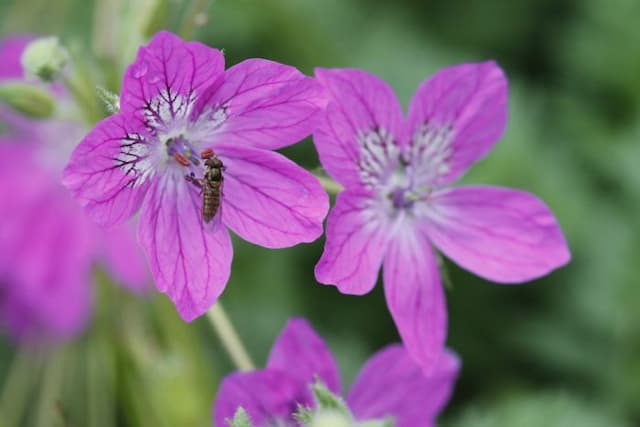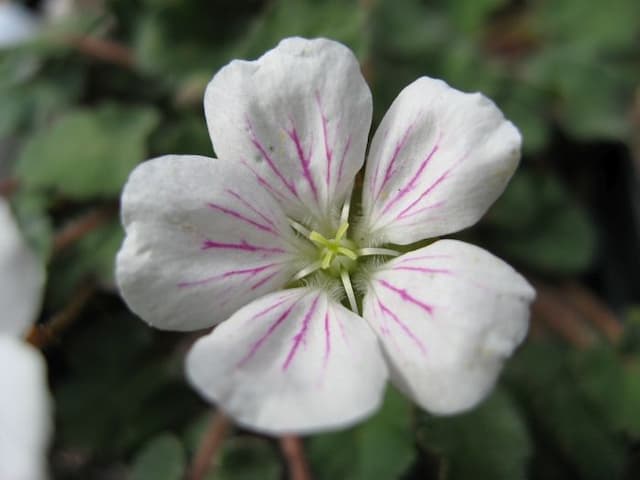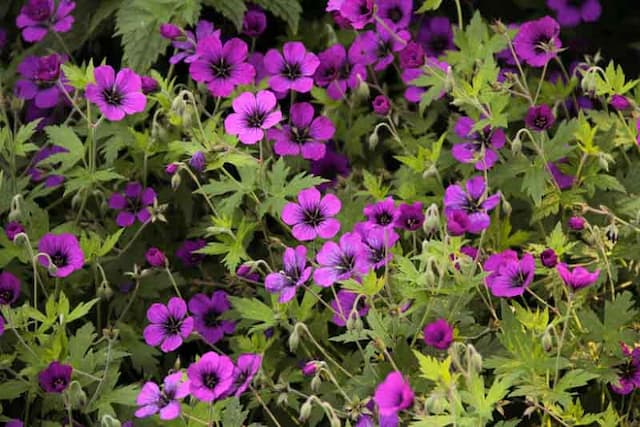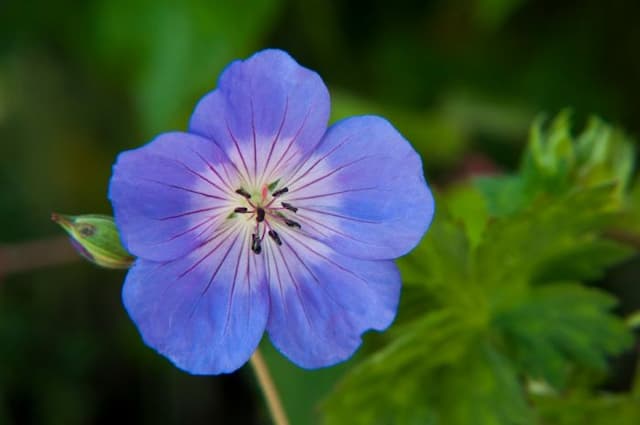Scented Geranium Pelargonium 'Blackcurrant Yhu' (Dec)

ABOUT
The Pelargonium 'Blackcurrant Yhu', commonly known as a type of geranium, is a visually striking plant. This variety features richly colored foliage that may have a unique hue, hinting at a deep, dark coloring which could be contrasted by brighter or variegated edges. The leaves are typically shaped with an irregular outline, exhibiting a lobed structure often associated with geranium leaves. The flowers of this geranium are also notable, typically presented in clusters, also known as inflorescences. Each blossom can have a round to slightly cupped shape, contributing to an overall lush appearance. The petals might be adorned with various shades, possibly displaying a deep, velvety texture. The center of the flowers often have a different color, highlighting a pattern or a contrasting hue which could be vibrant against the darker petals. Stems can be sturdy, supporting the weight of the leaves and flowers. They might have a green that complements the foliage, with a surface that could range from smooth to slightly hairy. The overall effect of the plant is one of robust vitality, offering a sensory experience not just visually but possibly also aromatic, as geraniums are known for their fragrant leaves when touched or crushed.
About this plant
 Names
NamesFamily
Geraniaceae
Synonyms
Scented Geranium, Blackcurrant Scented Pelargonium
Common names
Pelargonium 'Blackcurrant Yhu' (Dec).
 Toxicity
ToxicityTo humans
The most common common name for Pelargonium 'Blackcurrant Yhu' is scented geranium. Scented geraniums are generally considered non-toxic to humans. However, it is always advisable to avoid ingesting plants not meant for consumption as individual sensitivities can vary. If ingested in large quantities, mild gastrointestinal upset could occur, but this is not common.
To pets
The most common common name for Pelargonium 'Blackcurrant Yhu' is scented geranium. Scented geraniums are also generally considered non-toxic to pets. However, as with humans, individual pets may have different sensitivities, and eating non-food plants can sometimes result in mild gastrointestinal upset such as vomiting or diarrhea. If a pet consumes a significant amount, it's recommended to monitor them and consult a veterinarian if any concerning symptoms arise.
 Characteristics
CharacteristicsLife cycle
Perennials
Foliage type
Deciduous
Color of leaves
Green
Flower color
Varies
Height
2 feet (60 cm)
Spread
2 feet (60 cm)
Plant type
Shrub
Hardiness zones
10
Native area
South Africa
Benefits
 General Benefits
General Benefits- Aesthetic Appeal: The Pelargonium 'Blackcurrant Yhu' adds color and visual interest to gardens and homes with its vibrant flowers and foliage.
- Fragrance: The plant is known for its pleasant, blackcurrant-like scent that can provide a natural and soothing fragrance to the area it occupies.
- Ease of Cultivation: This variety of geranium is relatively easy to grow, requiring minimal care, making it suitable for novice gardeners.
- Drought Resistance: It is quite drought-tolerant, which is ideal for xeriscaping or gardens in areas with water restrictions.
- Pest Deterrence: Geraniums are known to help deter certain pests, making them useful companion plants in vegetable gardens or around outdoor seating areas.
- Versatility: It can be grown in pots, containers, hanging baskets, or directly in the garden bed, providing flexibility in garden design and space utilization.
- Long Blooming Period: The plant typically has a lengthy blooming season, offering flowers from spring to fall for extended enjoyment.
 Medical Properties
Medical PropertiesThis plant is not used for medical purposes.
 Air-purifying Qualities
Air-purifying QualitiesThis plant is not specifically known for air purifying qualities.
 Other Uses
Other Uses- Creative Arts and Crafts: The vivid colors and unique texture of the pelargonium leaves can be used in pressed flower projects or to create natural dyes for fabrics and papers.
- Garden Design: Pelargoniums are often used as "spiller" plants in container gardening, enhancing visual interest by cascading over the edge of pots.
- Culinary Garnish: The attractive foliage of pelargoniums can be used to add a decorative touch to plates when plating dishes, though care should be taken to ensure they are not ingested if not of an edible variety.
- Photography Subjects: With their deeply colored leaves, Pelargonium 'Blackcurrant Yhu' can be a captivating subject for botanical photographers.
- Scent Enhancement: Pelargonium leaves, when crushed or brushed against, can release a pleasant fragrance, making them useful in areas where a natural scent is desired.
- Educational Tools: Gardeners and educators may use pelargonium plants to teach about plant propagation, as they are easily propagated from cuttings.
- Landscape Contrast: The dark foliage of Pelargonium 'Blackcurrant Yhu' can provide excellent contrast in flower beds, making surrounding colors pop.
- Companion Planting: Some gardeners plant pelargoniums near vegetables as they believe the strong scent can deter certain pests (although scientific evidence on this may be limited).
- Seasonal Displays: Pelargoniums can be featured in seasonal floral arrangements or displays, particularly in autumn due to their deep tones.
- Theme Gardens: This plant can be incorporated into a "chocolate" or "dessert" themed garden due to the rich, dark colors and aromatic foliage reminiscent of blackcurrant.
Interesting Facts
 Feng Shui
Feng ShuiThe Scented Geranium is not used in Feng Shui practice.
 Zodiac Sign Compitability
Zodiac Sign CompitabilityThe Scented Geranium is not used in astrology practice.
 Plant Symbolism
Plant Symbolism- Comfort: The scent of 'Blackcurrant Yhu', similar to other scented geraniums, can evoke a sense of comfort and homeliness.
- Healing: Geraniums are often associated with health and healing due to their use in traditional medicine and aromatherapy.
- Friendship: Geraniums can symbolize close friendships, perhaps because of their nurturing growth and pleasant fragrance.
- Surprise: The unique dark hue of 'Blackcurrant Yhu' might represent the delight of unexpected beauty in the plant world.
 Water
WaterThe Scented Geranium should be watered when the top inch of soil feels dry to the touch, typically every 7 to 10 days, but this can vary depending on environmental conditions. Use lukewarm water and slowly pour it around the base of the plant until the water runs through the drainage holes, which usually takes about 1 to 2 gallons for a medium-sized container. Avoid overhead watering to prevent leaf and stem diseases. During winter, reduce watering frequency to prevent root rot, as the plant's water needs decrease with lower light and cooler temperatures.
 Light
LightScented Geraniums prefer bright, indirect sunlight and will thrive in a spot that receives at least 6 hours of light per day. They should be placed near a south or west-facing window for optimum growth. However, protect them from intense midday sun, which can scorch their leaves, by using sheer curtains or moving them slightly away from the window.
 Temperature
TemperatureScented Geraniums favor temperatures between 65 and 75 degrees Fahrenheit for optimal growth. They can survive minimum temperatures of around 50 degrees Fahrenheit but should not be exposed to frost. To prevent cold damage, keep them away from drafty windows and doors during the winter months.
 Pruning
PruningScented Geraniums benefit from regular pruning to encourage bushier growth and prevent legginess. Prune in early spring before new growth starts, cutting back up to one-third of the plant. Remove dead or yellowing leaves and spent flowers as needed throughout the year to keep the plant tidy and healthy. Pruning just after a flush of bloom encourages another round of flowers.
 Cleaning
CleaningAs needed
 Soil
SoilFor the scented geranium (common name), a well-draining soil mixture is ideal, composed of two parts peat moss or coco coir, one part perlite or coarse sand, and one part potting soil. The optimal soil pH should be slightly acidic to neutral, around 6.0 to 7.0.
 Repotting
RepottingScented geraniums should be repotted annually or when they have outgrown their current container, which is typically every 1 to 2 years. Ensure the new pot is only slightly larger than the previous one.
 Humidity & Misting
Humidity & MistingScented geraniums prefer moderate humidity levels, around 40-50%. Avoid overly humid conditions to prevent fungal diseases and maintain plant health.
 Suitable locations
Suitable locationsIndoor
Place scented geranium in bright, indirect light and rotate for even growth.
Outdoor
Scented geranium requires sunny spot, sheltered from strong winds.
Hardiness zone
9-11 USDA
 Life cycle
Life cycleThe life of the Pelargonium 'Blackcurrant Yhu', also known as Scented Geranium, begins with seed germination, typically in warm, moist soil in a sunny location. After germination, the plant enters the seedling stage, establishing its root system and first true leaves as it begins to photosynthesize and grow. As the plant matures, it enters the vegetative stage, where it develops a robust stem, a bushy structure with aromatic leaves, and begins to produce the oils responsible for its characteristic scent. The flowering stage follows, with the plant producing clusters of small, attractive flowers, often in shades of pink, red, or white, which can attract pollinators. Once pollination occurs, the plant sets seeds, allowing it to reproduce and complete its life cycle. Throughout the growing season, the Scented Geranium can be pruned and harvested for its fragrant leaves, which are used in a variety of culinary, decorative, and medicinal applications.
 Propogation
PropogationPropogation time
Spring-Early Summer
Propogation: The Pelargonium 'Blackcurrant Yhu', commonly known as a type of scented geranium, is typically propagated by stem cuttings, a method favored for its simplicity and high success rate. To propagate using this method, choose a healthy stem that is about 3 to 4 inches (7.6 to 10.2 cm) long, ensuring that it has at least three leaf nodes. The cutting is taken just below a node, where there is a concentration of hormones to encourage root growth. The lower leaves are removed, and the cut end may be dipped in rooting hormone powder to enhance root development, although this step is optional. The cutting is then inserted into a pot filled with a moistened potting mix or starting medium that is well-draining. It is important to keep the cuttings in a warm, bright location out of direct sunlight and maintain the humidity around them until the roots have established, which typically takes a few weeks. After the roots have formed, the new plant can be transferred to a larger pot or garden area.







![Cranesbill [Rothbury Gem]](/_next/image?url=https%3A%2F%2Fplants-admin.emdemapps.com%2Fimages%2Fplants%2F%2Fimages%2F604b6243984c2.png&w=640&q=75)

